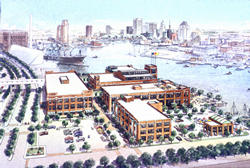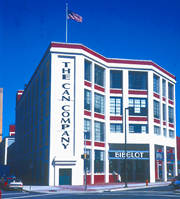Utilizing the latest in flash technology, E&EM doctoral student Elvin Yuzugullu produced a new web site this past summer providing information on GW’s three-year, EPA sponsored brownfields research project. The research project, completed in September 2001 by E&EM doctoral candidate Jerry Sherk, represents the first significant attempt to quantify reduced pressures on previously undeveloped properties (“greenfields sites”) from the redevelopment of urban sites. In addition, the project identified and evaluated, using primary data sources, obstacles to the redevelopment of brownfields sites in existing federal, state and local statutes and regulations.
The new web site can be found at the following link: http://www.gwu.edu/~eem/Brownfields/index.htm
The term "brownfields" includes unused or underutilized urban sites that are (or may have been) contaminated by prior use. It has been estimated that as many as 650,000 brownfield sites exist in the United States and that the total cost of restoring these sites to productive use may be in excess of $650 billion. Redevelopment of brownfields, it has been argued, is a key factor in ameliorating "urban sprawl" and the adverse social, economic and environmental impacts associated therewith.
The American Can Company has been a longtime landmark along Canton's revitalized waterfront. The $19 million renovation was an opportunity to promote Smart Growth by transforming it into a vibrant retail and office center. The Can Company was the first Maryland property to successfully complete the Brownfield's Voluntary Clean-Up Program for the Maryland Department of the Environment. |
The study summarized on the new web site addressed four questions. The first of these focused on the extent to which the redevelopment of brownfields reduces developmental pressures on undeveloped suburban or rural areas ("greenfields"). The second question concerned economic benefits that are induced by the redevelopment of brownfields. Statutes and regulations that either inhibit the redevelopment of brownfields or that encourage the development of greenfields were the focus of questions three and four. Question three addressed federal statutes and regulations while question four addressed statutes and regulations at the state and local level.
In addition to answering these questions, this research shed light on answers to two key, higher-level, questions. First, does the redevelopment of brownfields actually serve as a check or constraint on urban sprawl? Second, what are the critical factors (and the relative weights of those factors) that most influenced specific decisions to redevelop brownfields?

The former Procter & Gamble soap factory, circa 1929, will be converted to a 400,000-s.f. corporate office campus. Included in the project will be a 1/4 acre waterfront promenade and a 5,000-s.f. restaurant with outdoor dining. Views of downtown Baltimore and the Inner Harbor are spectacular. |
The first of these two higher-level questions is of particular relevance regarding the development of "greenfields" (previously undeveloped lands such as agricultural or forest lands). To answer this question, successful brownfield redevelopment projects were analyzed in terms of the amount of land that the same project would have required if it had been developed in a greenfield area.
Calculation of these "areal differentials" indicated that, of the 142 samples (derived from 48 specific brownfield redevelopment projects) that were analyzed in the study, 108 (76.1%) would have required more land in a greenfield area than was actually used by the brownfield redevelopment project. The total area of land used by all of the brownfield redevelopment projects was 142.7 acres. Had these same projects been constructed in a greenfield area, a minimum of 645.9 acres would have been required. When subdivided by category, the data indicate that the redevelopment of one acre of brownfields (1) if for industrial purposes, would have required 6.2 acres in a greenfield area (95% confidence interval: ± 5.4 acres), (2) if for commercial purposes, would have required 2.4 acres in a greenfield area (95% confidence interval: ± 0.6 acres) and (3) if for residential purposes would have required 5.6 acres in a greenfield area (95% confidence interval: ± 2.5 acres). Of the 142 samples, 19 of 29 industrial samples (65.5%), 39 of 53 commercial samples (73.6%) and 50 of 60 residential samples (83.3%) would have required more land if the specific redevelopment project had been located in a greenfield area.


